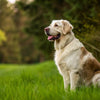How to Exercise an Aggressive Dog: A Comprehensive Guide for Pet Owners
- Houndsy
Table of Contents
- Introduction
- Understanding Aggression in Dogs
- The Exercise-Behavior Connection
- Creating an Effective Exercise Program
- Safety First: Precautions to Consider
- Additional Resources for Pet Owners
- Conclusion
- FAQs
Introduction
Did you know that approximately 70% of aggressive behaviors in dogs can be mitigated through regular exercise and mental stimulation? If you’re a pet owner grappling with an aggressive dog, this statistic may provide a glimmer of hope. As dog lovers, we understand the challenges that come with owning a dog that displays aggression. It can be alarming and stressful—not just for you but for your furry friend too. However, there’s a powerful solution lurking right in front of us: exercise.
In this blog post, we will explore how to effectively exercise an aggressive dog, addressing the underlying causes of aggression and demonstrating how a well-structured exercise routine can transform your dog into a calmer, happier companion. We’ll cover various techniques, activities, and tips to help you and your pet navigate this journey together. By the end, you’ll have a comprehensive understanding of how to implement a tailored exercise program that suits your dog’s unique needs.
So, let’s dive in and discover how we can create a more harmonious living environment for both you and your beloved canine!
Understanding Aggression in Dogs
Before we delve into the exercise techniques, it’s vital to understand what aggression really means in the context of canine behavior. Aggression in dogs can manifest in various forms, such as growling, barking, lunging, or even biting. Often, these behaviors stem from fear, anxiety, territorial instincts, or past traumas. By recognizing the root causes, we can better address the behavior and implement strategies to reduce it.
Common Causes of Aggression
- Fear or Anxiety: Many dogs display aggression when they feel threatened. This can be due to a lack of socialization or previous negative encounters.
- Territorial Behavior: Dogs are instinctively protective of their territory, which can lead to aggressive behavior when they perceive intrusions.
- Pain or Illness: A dog in pain may lash out unexpectedly. Regular vet check-ups are crucial to rule out medical issues.
- Resource Guarding: Some dogs may guard food, toys, or even their owners, leading to aggressive displays when they feel their possessions are threatened.
- Past Trauma: Dogs rescued from abusive situations may have ingrained fears that result in aggressive behavior.
Understanding these triggers is the first step in devising a successful exercise plan.
The Exercise-Behavior Connection
Research has proven that there’s a strong link between physical activity and behavior in dogs. Regular exercise not only expends energy but also helps to release endorphins, improving mood and reducing stress. So how does this connection specifically apply to aggressive dogs?
The Benefits of Regular Exercise
- Reduces Stress: Exercise helps to lower cortisol levels (the stress hormone) in dogs, which can lead to calmer behavior.
- Promotes Positive Behavior: Well-exercised dogs are generally happier and more balanced, leading to fewer instances of aggression.
- Improves Socialization: Regular outings can help your dog become more accustomed to different environments, people, and other pets, reducing fear-based reactions.
- Enhances Focus and Training: A tired dog is often more receptive to training, making it easier to reinforce positive behaviors.
In short, by integrating a structured exercise routine into our dogs' lives, we can significantly diminish their aggressive tendencies.
Creating an Effective Exercise Program
Now that we understand the benefits of exercise, let’s explore how to create an effective exercise program tailored to our dogs’ needs. Here are some key steps to consider:
Assess Your Dog's Needs
The first step is to assess your dog's energy levels and specific needs. Consider factors such as breed, age, and temperament. For instance, high-energy breeds like Border Collies may require more vigorous exercise than low-energy breeds like Bulldogs.
- High-Energy Breeds: Require 60–120 minutes of exercise daily. Activities may include running, agility training, or interactive play.
- Medium-Energy Breeds: Typically need 30–60 minutes of exercise. Regular walks, fetch, and light play may suffice.
- Low-Energy Breeds: May only need 30 minutes of low to moderate exercise daily. Short walks and indoor play can be effective.
Build a Routine
Consistency is key when it comes to exercising our dogs. Establish a daily routine that includes various activities to keep things engaging. Here’s an example of a weekly exercise plan for a dog with aggressive tendencies:
- Monday: 30-minute walk followed by a 15-minute fetch session.
- Tuesday: 20 minutes of nose-work games (hiding treats around the house).
- Wednesday: 45-minute hike in a dog-friendly area.
- Thursday: 30-minute play session with interactive toys.
- Friday: 20-minute training session focusing on impulse control commands (like “sit” or “stay”).
- Saturday: Agility training at a local dog park.
- Sunday: Rest day with light indoor play.
Incorporate Mental Stimulation
Physical exercise should be complemented with mental challenges to keep our dogs engaged and focused. Here are some exciting activities to consider:
- Puzzle Toys: These toys are designed to stimulate your dog’s problem-solving abilities while delivering treats as rewards.
- Nose-Work Games: Teach your dog to find hidden treats around the house or yard, tapping into their natural instincts.
- Basic Training Commands: Regularly practicing commands helps reinforce good behavior and keeps your dog mentally sharp.
Monitor Progress and Adjust
As we implement these exercises, it’s essential to monitor our dog's behavior and progress. If you notice improvements in their aggression levels, continue with the established routine. If aggression persists, consider consulting a professional dog trainer for guidance.
Safety First: Precautions to Consider
When exercising an aggressive dog, safety should be our top priority. Here are some precautions to take:
- Use a Leash: Always keep your dog on a leash during walks, especially in public areas where they might encounter other dogs or people.
- Muzzle Training: If your dog has a history of aggression, consider introducing a muzzle during walks to prevent any unforeseen incidents.
- Controlled Environments: Choose safe, enclosed spaces for off-leash play where your dog can interact with others without the risk of aggression.
Additional Resources for Pet Owners
To further support our mission of enhancing the dog-feeding and care experience, we recommend exploring our flagship product, the Houndsy Kibble Dispenser. This innovative design not only makes feeding convenient but also encourages healthy eating habits, which can be beneficial for your dog’s overall well-being.
Conclusion
In summary, effectively exercising an aggressive dog involves understanding the underlying causes of their behavior, creating a structured exercise program, and incorporating mental stimulation. By dedicating time and effort to this process, we can help our furry friends become calmer and more balanced companions.
As we work through this journey, it’s crucial to remain patient and consistent. Each dog is unique, and finding the right approach may take time. Remember, the goal is not just to manage aggression but to foster a loving, trusting relationship with our pets.
Are you ready to take the first steps in transforming your dog’s behavior? Let’s work together to create a happier, more harmonious home for both you and your furry friend!
FAQs
1. How long should I exercise my aggressive dog each day?
The amount of exercise needed varies by breed and energy level, but aim for at least 30 minutes to 2 hours of physical activity per day, combined with mental stimulation.
2. What types of activities are best for aggressive dogs?
Physical activities such as walking, running, fetch, and agility training are excellent choices, along with mental challenges like puzzle toys and nose-work games.
3. Should I consult a professional trainer for my aggressive dog?
Yes, if your dog’s aggression is severe or persists despite your efforts, enlisting the help of a certified dog trainer or behaviorist is highly recommended.
4. Can exercise alone solve my dog’s aggression problems?
While exercise is a powerful tool in managing aggression, it should be combined with training, socialization, and, if necessary, professional guidance for the best results.
5. What if my dog becomes aggressive during exercise?
If your dog displays aggressive behavior during exercise, it’s important to stop the activity and seek advice from a professional trainer to address the underlying issues safely.
By understanding how to exercise an aggressive dog effectively, we can create a positive impact on their behavior, leading to a happier and more harmonious life together.












